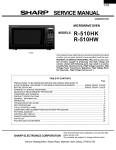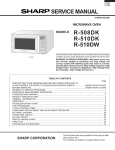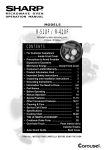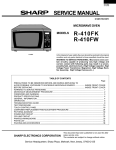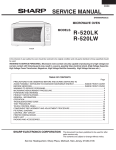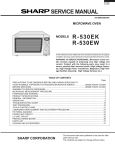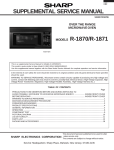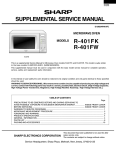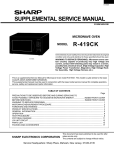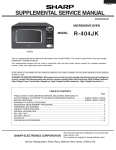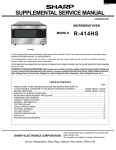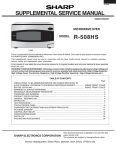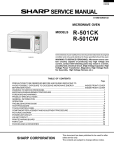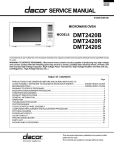Download Sharp R-410F Service manual
Transcript
R- 509FW SUPPLEMENTAL SERVICE MANUAL S22M183R509FE MICROWAVE OVEN MODEL R-509FW R-509FW This is a supplemental Service Manual for Microwave Oven model R-509FW. This model is quite similar to the base models; R-510FK/FW (S12M182R510FE). This supplemental manual must be used in conjunction with the base model service manual for complete operation, service, safety and replacement parts information. In the interest of user-safety the oven should be restored to its original condition and only parts identical to those specified should be used. WARNING TO SERVICE PERSONNEL: Microwave ovens contain circuitry capable of producing very high voltage and current, contact with following parts may result in a severe, possibly fatal, electrical shock. (High Voltage Capacitor, High Voltage Power Transformer, Magnetron, High Voltage Rectifier Assembly, High Voltage Harness etc..) TABLE OF CONTENTS Page PRECAUTIONS TO BE OBSERVED BEFORE AND DURING SERVICING TO AVOID POSSIBLE EXPOSURE TO EXCESSIVE MICROWAVE ENERGY ................... INSIDE FRONT COVER BEFORE SERVICING ...................................................................................................... INSIDE FRONT COVER WARNING TO SERVICE PERSONNEL ................................................................................................................ 1 MICROWAVE MEASUREMENT PROCEDURE .....................................................................................................2 FOREWORD AND WARNING ................................................................................................................................3 PRODUCT SPECIFICATIONS ............................................................................................................................... 4 GENERAL INFORMATION ...................................................................................................................................4 OPERATION .........................................................................................................................................................6 TEST PROCEDURE .............................................................................................................................................. 8 TOUCH CONTROL PANEL .................................................................................................................................. 12 CPU UNIT CIRCUIT ............................................................................................................................................. 16 PARTS LIST ........................................................................................................................................................ 17 PACKING AND ACCESSORIES ......................................................................................................................... 21 SHARP ELECTRONICS CORPORATION This document has been published to be used for after sales service only. The contents are subject to change without notice. Service Headquarters: Sharp Plaza, Mahwah, New Jersey, 07430-2135 R-509FW PRECAUTIONS TO BE OBSERVED BEFORE AND DURING SERVICING TO AVOID POSSIBLE EXPOSURE TO EXCESSIVE MICROWAVE ENERGY (a) Do not operate or allow the oven to be operated with the door open. (b) Make the following safety checks on all ovens to be serviced before activating the magnetron or other microwave source, and make repairs as necessary: (1) interlock operation, (2) proper door closing, (3) seal and sealing surfaces (arcing, wear, and other damage), (4) damage to or loosening of hinges and latches, (5) evidence of dropping or abuse. (c) Before turning on microwave power for any service test or inspection within the microwave generating compartments, check the magnetron, wave guide or transmission line, and cavity for proper alignment, integrity, and connections. (d) Any defective or misadjusted components in the interlock, monitor, door seal, and microwave generation and transmission systems shall be repaired, replaced, or adjusted by procedures described in this manual before the oven is released to the owner. (e) A microwave leakage check to verify compliance with the Federal Performance Standard should be performed on each oven prior to release to the owner. BEFORE SERVICING Before servicing an operative unit, perform a microwave emission check as per the Microwave Measurement Procedure outlined in this service manual. If microwave emissions level is in excess of the specified limit, contact SHARP ELECTRONICS CORPORATION immediately @1-800-237-4277. If the unit operates with the door open, service person should 1) tell the user not to operate the oven and 2) contact SHARP ELECTRONICS CORPORATION and Food and Drug Administration's Center for Devices and Radiological Health immediately. Service personnel should inform SHARP ELECTRONICS CORPORATION of any certified unit found with emissions in excess of 4mW/cm2. The owner of the unit should be instructed not to use the unit until the oven has been brought into compliance. R-509FW WARNING TO SERVICE PERSONNEL Microwave ovens contain circuitry capable of producing very high voltage and current, contact with following parts may result in a severe, possibly fatal, electrical shock. (Example) High Voltage Capacitor, High Voltage Power Transformer, Magnetron, High Voltage Rectifier Assembly, High Voltage Harness etc.. Read the Service Manual carefully and follow all instructions. Don't Touch ! Danger High Voltage When the testing is completed, 1. Disconnect the power supply cord, and then remove outer case. 2. Open the door and block it open. 3. Discharge high voltage capacitor. 4. Reconnect the leads to the primary of the power transformer. 5. Reinstall the outer case (cabinet). 6. Reconnect the power supply cord after the outer case is installed. 7. Run the oven and check all functions. Before Servicing 1. Disconnect the power supply cord remove outer case. 2. Open the door and block it open. 3. Discharge high voltage capacitor. , and then WARNING:RISK OF ELECTRIC SHOCK. DISCHARGE THE HIGH-VOLTAGE CAPACITOR BEFORE SERVICING. After repairing The high-voltage capacitor remains charged about 60 seconds after the oven has been switched off. Wait for 60 seconds and then short-circuit the connection of the highvoltage capacitor (that is the connecting lead of the highvoltage rectifier) against the chassis with the use of an insulated screwdriver. 1. Reconnect all leads removed from components during testing. 2. Reinstall the outer case (cabinet). 3. Reconnect the power supply cord after the outer case is installed. 4. Run the oven and check all functions. Whenever troubleshooting is performed the power supply must be disconnected. It may, in some cases, be necessary to connect the power supply after the outer case has been removed, in this event: 1. Disconnect the power supply cord, and then remove outer case. 2. Open the door and block it open. 3. Discharge high voltage capacitor. 4. Disconnect the leads to the primary of the power transformer. 5. Ensure that the leads remain isolated from other components and oven chassis by using insulation tape. 6. After that procedure, reconnect the power supply cord. Microwave ovens should not be operated empty. To test for the presence of microwave energy within a cavity, place a cup of cold water on the oven turntable, close the door and set the power to HIGH and set the microwave timer for two (2) minutes. When the two minutes has elapsed (timer at zero) carefully check that the water is now hot. If the water remains cold carry out Before Servicing procedure and reexamine the connections to the component being tested. When all service work is completed and the oven is fully assembled, the microwave power output should be checked and a microwave leakage test should be carried out. 1 R-509FW MICROWAVE MEASUREMENT PROCEDURE A. Requirements: 1) Microwave leakage limit (Power density limit): The power density of microwave radiation emitted by a microwave oven should not exceed 1mW/cm2 at any point 5cm or more from the external surface of the oven, measured prior to acquisition by a purchaser, and thereafter (through the useful life of the oven), 5 mW/cm2 at any point 5cm or more from the external surface of the oven. 2) Safety interlock switches: Primary interlock relay switch shall prevent microwave radiation emission in excess of the requirement as above mentioned. Secondary interlock relay and door sensing switch shall prevent microwave radiation emission in excess of 5 mW/cm2 at any point 5cm or more from the external surface of the oven. B. Preparation for testing: Before beginning the actual measurement of leakage, proceed as follows: 1) Make sure that the actual instrument is operating normally as specified in its instruction booklet. Important: Survey instruments that comply with the requirement for instrumentation as prescribed by the performance standard for microwave ovens, 21 CFR 1030.10(c)(3)(i), must be used for testing. 2) Place the oven tray in the oven cavity. 3) Place the load of 275±15 ml (9.8 oz) of tap water initially at 20±5O C (68OF) in the center of the oven cavity. The water container shall be a low form of 600 ml (20 oz) beaker with an inside diameter of approx. 8.5 cm (3-1/2 in.) and made of an electrically nonconductive material such as glass or plastic. The placing of this standard load in the oven is important not only to protect the oven, but also to insure that any leakage is measured accurately. 4) Set the cooking control on Full Power Cooking Mode. 5) Close the door and select a cook cycle of several minutes. If the water begins to boil before the survey is completed, replace it with 275 ml of cool water. C. Leakage test: Closed-door leakage test (microwave measurement): 1) Grasp the probe of the survey instrument and hold it perpendicular to the gap between the door and the body of the oven. 2) Move the probe slowly, not faster than 1 in./sec. (2.5 cm/sec.) along the gap, watching for the maximum indication on the meter. 3) Check for leakage at the door screen, sheet metal seams and other accessible positions where the continuity of the metal has been breached (eg., around the switches, indicator, and vents). While testing for leakage around the door, pull the door away from the front of the oven as far as is permitted by the closed latch assembly. 4) Measure carefully at the point of highest leakage and make sure that the highest leakage is no greater than 4mW/cm2, and that the primary interlock switch/secondary interlock relay does turn the oven OFF before any door movement. NOTE: After servicing, record data on service invoice and microwave leakage report. 2 R-509FW SERVICE MANUAL PRODUCT DESCRIPTION MICROWAVE OVEN R-509FW GENERAL INFORMATION FOREWORD This Manual has been prepared to provide Sharp Electronics Corp. Service Personnel with Operation and Service Information for the SHARP MICROWAVE OVEN, R-509FW. It is recommended that service personnel carefully study the entire text of this manual so that they will be qualified to render satisfactory customer service. OPERATION TROUBLESHOOTING GUIDE AND TEST PROCEDURE Check the interlock switches and the door seal carefully. Special attention should be given to avoid electrical shock and microwave radiation hazard. TOUCH CONTROL PANEL WARNING Never operate the oven until the following points are ensured: (A) The door is tightly closed. (B) The door brackets and hinges are not defective. (C) The door packing is not damaged. (D) The door is not deformed or warped. (E) There is no other visible damage with the oven. WIRING DIAGRAM Servicing and repair work must be carried out only by trained service personnel. PARTS LIST DANGER Certain initial parts are intentionally not grounded and present a risk of electrical shock only during servicing. Service personnel - Do not contact the following parts while the appliance is energized; High Voltage Capacitor, Power Transformer, Magnetron, High Voltage Rectifier Assembly, High Voltage Harness; If provided, Vent Hood, Fan assembly, Cooling Fan Motor. All the parts marked “*” on parts list are used at voltages more than 250V. Removal of the outer wrap gives access to voltage above 250V. All the parts marked “∆” on parts list may cause undue microwave exposure, by themselves, or when they are damaged, loosened or removed. SHARP ELECTRONICS CORPORATION SHARP PLAZA, MAHWAH, NEW JERSEY 07430-2135 3 R-509FW SPECIFICATION ITEM DESCRIPTION PowerRequirements 120 Volts 13.3 Amperes, 1600 watts 60 Hertz Single phase, 3 wire grounded Power Output 1100 watts (IEC 705 TEST PROCEDURE) Operating frequency of 2450MHz Case Dimensions Width 24" Height 13-3/8" Depth 19-1/8" Cooking Cavity Dimensions Width 17-3/8" Height 10-1/2" Depth 18-5/8" 1.8 Cubic Feet Control Complement Touch Control System Clock ( 1:00 - 12:59 ) Timer (0 - 99 min. 99 seconds) Microwave Power for Variable Cooking Repetition Rate; P-HI .................................................. Full power throughout the cooking time P-90 .................................................................... approx. 90% of Full Power P-80 .................................................................... approx. 80% of Full Power P-70 .................................................................... approx. 70% of Full Power P-60 .................................................................... approx. 60% of Full Power P-50 .................................................................... approx. 50% of Full Power P-40 .................................................................... approx. 40% of Full Power P-30 .................................................................... approx. 30% of Full Power P-20 .................................................................... approx. 20% of Full Power P-10 .................................................................... approx. 10% of Full Power P-0 ...................................................... No power throughout the cooking time MINUTE PLUS pad, Cook pads, Defrost center pads, Reheat pads, Number selection pads, Power Level pad, Timer/Clock pad,Stop/Clear pad, START pad, and Popcorn. Oven Cavity Light Yes Safety Standard UL Listed FCC Authorized Complies with DHHS Rules, CFR, Title 21, Chapter 1, Subchapter J GENERAL INFORMATION GROUNDING INSTRUCTIONS This oven is equipped with a three prong grounding plug. It must be plugged into a wall receptacle that is properly installed and grounded in accordance with the National Electrical Code and local codes and ordinances. In the event of an electrical short circuit, grounding reduces the risk of electric shock by providing an escape wire for the electric current. WARNING: Improper use of the grounding plug can result in a risk of electric shock. Electrical Requirements The electrical requirements are a 120 volt 60 Hz, AC only, 15 or 20 amp. fused electrical supply. It is recommended that a separate circuit serving only this appliance be provided. When installing this appliance, observe all applicable codes and ordinances. A short power-supply cord is provided to reduce risks of becoming entangled in or tripping over a longer cord. Where a two-pronged wall-receptacle is encountered, it is the personal responsibility and obligation of the customer to contact 4 R-509FW a qualified electrician and have it replaced with a properly grounded three-pronged wall receptacle or have a grounding adapter properly grounded and polarized. If the extension cord must be used, it should be a 3-wire, 15 amp. or higher rated cord. Do not drape over a countertop or table where it can be pulled on by children or tripped over accidentally. Grounded Receptacle Box 3-Pronged CAUTION: DO NOT UNDER ANY CIRCUMSTANCES CUT OR RE- Plug MOVE THE ROUND GROUNDING PRONG FROM THIS Grounding Pin PLUG. 3-Pronged Receptacle OVEN DIAGRAM 1. One touch door open button. Push to open door. 2. Door latches. The oven will not operate unless the door is securely closed. 3. Removable turntable support. 4. Removable turntable. The turntable will rotate clockwise or counterclockwise. 5. Oven lamp. It will light when oven is operating or door is opened. 6. Oven door with see-through window. 7. Ventilation openings. (Rear) 8. Auto-Touch control panel. 9. Time display: Digital display, 99 minutes 99 seconds. 5 6 7 9 2 11 8 10 1 4 3 10. Wave guide cover. 11. Power supply cord TOUCH CONTROL PANEL NOTE: The directed features are disabled after one minute when the oven is not in use. These features are automatically enabled when the door is opened and closed or the STOP/ CLEAR pad is pressed. R-509FW 5 R-509FW OPERATION DESCRIPTION OF OPERATING SEQUENCE The following is a description of component functions during oven operation. and is mechanically associated with the door so that it will function in the following sequence. (1) When the door opens from the closed position, the secondary interlock relay (RY2) and primary interlock switch open their contacts. And contacts of the relay (RY1) remains closed. Then the monitor switch contacts close. (2) When the door is closed from the open position, the monitor switch contacts open first. Then the contacts of the primary interlock switch and door sensing switch close. And contacts of the relay (RY1) open. If the primary interlock switch and secondary interlock relay (RY2) fail with the contacts closed when the door is opened, the closing of the monitor switch contacts will form a short circuit through the C/T fuse, primary interlock switch, relay (RY1) and secondary interlock relay (RY2), causing the C/T fuse to blow. OFF CONDITION Closing the door activates the door sensing switch and primary interlock switch. (In this condition, the monitor switch contacts are opened.) When oven is plugged in, 120 volts A.C. is supplied to the control unit. (Figure O-1). 1. The display will show flashing "88:88". To set any program or set the clock, you must first touch the STOP/CLEAR pad. The display will clear, and " : " will appear. COOKING CONDITION Program desired cooking time by touching the NUMBER pads. Program the power level by touching the POWER LEVEL pad and then a Number pad. When the START pad is touched, the following operations occur: POWER LEVEL P-0 TO P-90 COOKING When Variable Cooking Power is programmed, the 120 volts A.C. is supplied to the power transformer intermittently through the contacts of relay (RY-2) which is operated by the control unit within a 32 second time base. Microwave power operation is as follows: 1. The contacts of relays are closed and components connected to the relays are turned on as follows. (For details, refer to Figure O-2) RELAY RY-1 RY-2 VARI-MODE Power 10(P-HI) (100% power) Power 9(P-90) (approx. 90% power) Power 8(P-80) (approx. 80% power) Power 7(P-70) (approx. 70% power) Power 6(P-60) (approx. 60% power) Power 5(P-50) (approx. 50% power) Power 4(P-40) (approx. 40% power) Power 3(P-30) (approx. 30% power) Power 2(P-20) (approx. 20% power) Power 1(P-10) (approx. 10% power) Power 0(P-0) (0% power) CONNECTED COMPONENTS oven lamp/turntable motor/fan motor power transformer 2. 120 volts A.C. is supplied to the primary winding of the power transformer and is converted to about 3.3 volts A.C. output on the filament winding, and approximately 2370 volts A.C. on the high voltage winding. 3. The filament winding voltage heats the magnetron filament and the H.V. winding voltage is sent to a voltage doubler circuit. 4. The microwave energy produced by the magnetron is channelled through the waveguide into the cavity feedbox, and then into the cavity where the food is placed to be cooked. 5. Upon completion of the cooking time, the power transformer, oven lamp, etc. are turned off, and the generation of microwave energy is stopped. The oven will revert to the OFF condition. 6. When the door is opened during a cook cycle, the monitor switch, door sensing switch, primary interlock switch, relay (RY1) and secondary interlock relay are activated with the following results. The circuits to the turntable motor, the cooling fan motor, and the high voltage components are de-energized, the oven lamp remains on, and the digital read-out displays the time still remaining in the cook cycle when the door was opened. 7. The monitor switch electrically monitors the operation of the primary interlock switch and secondary interlock relay Note: 6 ON TIME 32 sec. OFF TIME 0 sec. 30 sec. 2 sec. 26 sec. 6 sec. 24 sec. 8 sec. 22 sec. 10 sec. 18 sec. 14 sec. 16 sec. 16 sec. 12 sec. 20 sec. 8 sec. 24 sec. 6 sec. 26 sec. 0 sec. 32 sec. The ON/OFF time ratio does not correspond with the percentage of microwave power, because approx. 2 seconds are needed for heating of the magnetron filament. R-509FW Note:* Indicates component SCHEMATIC NOTE: CONDITION OF OVEN 1. Door Closed 2. CLOCK APPEARS ON DISPLAY CAVITY TEMPERATURE FUSE C/T FUSE ORG ORG BRN ORG RED RED N.O. COM. B2 (RY1) CONTROL UNIT COM. ORG RED MONITOR SWITCH N.C. TURN TTM TABLE FM FAN MOTOR MOTOR OL OVEN LAMP HIGH VOLTAGE RECTIFIER COM. WHT WHT WHT GRY WHT HIGH VOLTAGE CAPACITOR F1 ORG ORG OVEN LAMP RELAY WHT WHT N.O. GND MAGNETRON F2 BRN 120VAC 60Hz F3 WHT WHT GRN HUMIDITY SENSOR B1 (RY2) SECONDARY INTERLOCK RELAY POWER TRANSFORMER RED RED DOOR SENSING SWITCH COM. N.O. WHT WHT GRY PRIMARY WHT INTERLOCK SWITCH Figure O-1 Oven Schematic - Off Condition SCHEMATIC NOTE: CONDITION OF OVEN 1. DOOR CLOSED 2. COOKING TIME PROGRAMMED 3. VARIABLE COOKING CONTROL "HIGH" 4. "START" PAD TOUCHED CAVITY TEMPERATURE FUSE C/T FUSE ORG ORG BRN ORG RED RED N.O. COM. B2 CONTROL UNIT COM. RED HIGH VOLTAGE CAPACITOR F1 ORG ORG BRN ORG MONITOR SWITCH N.C. TURN TTM TABLE FM FAN MOTOR MOTOR WHT WHT OL OVEN LAMP MAGNETRON WHT WHT (RY1) HUMIDITY SENSOR F2 OVEN LAMP RELAY WHT N.O. GRY WHT GND F3 HIGH VOLTAGE RECTIFIER COM. WHT WHT GRN 120VAC 60Hz B1 (RY2) SECONDARY INTERLOCK RELAY POWER TRANSFORMER RED RED DOOR SENSING SWITCH COM. N.O. WHT WHT GRY PRIMARY WHT INTERLOCK SWITCH Figure O-2 Oven Schematic - Cooking Condition 7 R-509FW TEST PROCEDURES PROCEDURE LETTER G MONITOR SWITCH TEST 1. 2. 3. 4. 5. 6. 7. 8. COMPONENT TEST Disconnect the power supply cord, and then remove outer case. Open the door and block it open. Discharge high voltage capacitor. Before performing this test, make sure that the primary interlock switch and the secondary interlock relay are operating properly, according to the above Switch Test Procedure. Disconnect the wire lead from the monitor switch (COM) terminal. Check the monitor switch operation by using the ohmmeter as follows. When the door is open, the meter should indicate a closed circuit. When the monitor switch actuator is pushed by a screw driver through the lower latch hole on the front plate of the oven cavity with the door opened (in this condition the plunger of the monitor switch is pushed in), the meter should indicate an open circuit. If improper operation is indicated, the switch may be defective. After testing the monitor switch, reconnect the wire lead to the monitor switch (COM) terminal and check the continuity of the monitor circuit. Reconnect all leads removed from components during testing. Reinstall the outer case (cabinet). Reconnect the power supply cord after the outer case is installed. Run the oven and check all functions. Red White/ White Screw Driver Ohmmeter Primary Interlock Switch I Monitor Switch TOUCH CONTROL PANEL ASSEMBLY TEST The touch control panel consists of circuits including semiconductors such as LSI, ICs, etc. Therefore, unlike conventional microwave ovens, proper maintenance cannot be performed with only a voltmeter and ohmmeter. In this service manual, the touch control panel assembly is divided into two units, Control Unit and Key Unit, and also the Control Unit is divided into two units, LSI Unit and Power Unit, and troubleshooting by unit replacement is described according to the symptoms indicated. Before testing, 1) Disconnect the power supply cord, and then remove outer case. 2) Open the door and block it open. 3) Discharge high voltage capacitor. 4) Disconnect the leads to the primary of the power transformer. 5) Ensure that these leads remain isolated from other components and oven chassis by using insulation tape. 1. Key Unit. NOTE : 1) Check Key unit ribbon connection before replacement. 2) Re-install the outer case (cabinet). 3) Reconnect the power supply cord after the outer case is installed. 4) Run the oven and check all functions. The following symptoms indicate a defective key unit. a) When touching the pads, a certain pad produces no signal at all. b) When touching a number pad, two figures or more are displayed. c) When touching the pads, sometimes a pad produces no signal. If the Key unit is defective. 8 R-509FW TEST PROCEDURES PROCEDURE LETTER COMPONENT TEST 1) Disconnect the power supply cord, and then remove outer case. 2) Open the door and block it open. 3) Discharge high voltage capacitor. 4) Replace the Key unit. 5) Reconnect all leads removed from components during testing. 6) Re-install the outer case (cabinet). 7) Reconnect the power supply cord after the outer case is installed. 8) Run the oven and check all functions. 2. Control Unit The following symptoms indicate a defective control unit. Before replacing the control unit, perform the Key unit test (Procedure J) to determine if control unit is faulty. 2-1 In connection with pads. a) When touching the pads, a certain group of pads do not produce a signal. b) When touching the pads, no pads produce a signal. 2-2 In connection with indicators a) At a certain digit, all or some segments do not light up. b) At a certain digit, brightness is low. c) Only one indicator does not light. d) The corresponding segments of all digits do not light up; or they continue to light up. e) Wrong figure appears. f) A certain group of indicators do not light up. g) The figure of all digits flicker. 2-3 Other possible problems caused by defective control unit. a) Buzzer does not sound or continues to sound. b) Clock does not operate properly. c) Cooking is not possible. When testing is completed, 1) Disconnect the power supply cord, and then remove outer case. 2) Open the door and block it open. 3) Discharge high voltage capacitor. 4) Reconnect all leads removed from components during testing. 5) Re-install the outer case (cabinet). 6) Reconnect the power supply cord after the outer case is installed. 7) Run the oven and check all functions.. J KEY UNIT TEST 1. Disconnect the power supply cord, and then remove outer case. 2. Open the door and block it open. 3. Discharge high voltage capacitor. 4. If the display fails to clear when the STOP/CLEAR pad is depressed, first verify the flat ribbon cable is making good contact, verify that the door sensing switch (stop switch) operates properly; that is the contacts are closed when the door is closed and open when the door is open. If the door sensing switch (stop switch) is good, disconnect the flat ribbon cable that connects the key unit to the control unit and make sure the door sensing switch is closed (either close the door or short the door sensing switch connecter). Use the Key unit matrix indicated on the control panel schematic and place a jumper wire between the pins that correspond to the STOP/CLEAR pad making momentary contact. If the control unit responds by clearing with a beep the key unit is faulty and must be replaced. If the control unit does not respond, it is faulty and must be replaced. If a specific pad does not respond, the above method may be used (after clearing the control unit) to determine if the control unit or key pad is at fault. 5. Reconnect all leads removed from components during testing. 9 R-509FW TEST PROCEDURES PROCEDURE LETTER COMPONENT TEST 6. Re-install the outer case (cabinet). 7. Reconnect the power supply cord after the outer case is installed. 8. Run the oven and check all functions. 7 6 5 4 3 2 START 1 5 TIMER CLOCK 9 COOK 4 8 STOP CLEAR 3 REHEAT 7 0 POWER LEVEL 6 10 9 8 POPCORN 1 MINUTE PLUS 14 13 12 11 DEFROST 2 Key Unit K RELAY TEST 1. Disconnect the power supply cord, and then remove outer case. 2. Open the door and block it open. 3. Discharge high voltage capacitor. 4. Disconnect the leads to the primary of the power transformer. 5. Ensure that these leads remain isolated from other components and oven chassis by using insulation tape. 6. After that procedure, re-connect the power supply cord. 7. Remove the outer case and check voltage between the normal open terminal of the relay RY1 and the normal open terminal of the relay RY2 on the control unit with an A.C. voltmeter.The meter should indicate 120 volts, if not check oven circuit. RY1 and RY2 Relay Test These relays are operated by D.C. voltage Check voltage at the relay coil with a D.C. voltmeter during the microwave cooking operation. DC. voltage indicated ............. Defective relay. DC. voltage not indicated ........ Check diode which is connected to the relay coil. If diode is good, control unit is defective. RELAY SYMBOL OPERATIONAL VOLTAGE CONNECTED COMPONENTS RY1 RY2 Approx. 12.0V D.C. Approx. 11.0V D.C. Oven lamp / Turntable motor / Cooling fan motor Power transformer 8. Disconnect the power supply cord, and then remove outer case. 9. Open the door and block it open. 10. Discharge high voltage capacitor. 11. Reconnect all leads removed from components during testing. 12. Re-install the outer case (cabinet). 13. Reconnect the power supply cord after the outer case is installed. 14. Run the oven and check all functions. L DEFROST TEST WARNING : The oven should be fully assembled before following procedure. (1) Place one cup of water in the center of the turntable tray in the oven cavity. (2) Close the door, touch the “ DEFROST “ pad once. (3) Touch the number pad “ 2 “ and then touch the number pad “ 5 “. (4) Touch the start pad. WEIGHT 0.5lb 1ST STAGE LEVEL TIME 60% 57sec. (5) The oven is in Defrost cooking condition. 10 2ND STAGE LEVEL TIME 40% 22sec. R-509FW TEST PROCEDURES PROCEDURE LETTER COMPONENT TEST (6) The oven will operate as follows. (in case of Steak/Chops 0.5lb) (7) If improper operation is indicated, the control unit is probably defective and should be checked. M FOIL PATTERN ON THE PRINTED WIRING BOARD TEST To protect the electronic circuits, this model is provided with a fine foil pattern added to the primary on the PWB, this foil pattern acts as a fuse. 1. Foil pattern check and repairs. 1) Disconnect the power supply cord, and then remove outer case. 2) Open the door and block it open. 3) Discharge high voltage capacitor. 4) Follow the troubleshooting guide given below for repair. STEPS OCCURRENCE CAUSE OR CORRECTION 1 Only pattern at "a" is broken. *Insert jumper wire J1 and solder. 2 Pattern at "a" and "b" are broken. *Insert the coil RCILF2003YAZZ between "c" and "d". 1 a RY2 c R b T1 5) Make a visual inspection of the varistor. Check for burned damage and examine the transformer with a tester for the presence of layer short-circuit (check the primary coil resistance which is approximately 540 ohms ± 20%). If any abnormal condition is detected, replace the defective parts. d RM7 (J1) -V49 A72M RCM 6) Reconnect all leads removed from components during testing. 7) Re-install the outer case (cabinet). 8) Reconnect the power supply cord after the outer case is installed. 9) Run the oven and check all functions. 2. Follow the troubleshooting guide given below, if indicator does not light up after above check and repairs are finished. 1) Disconnect the power supply cord, and then remove outer case. 2) Open the door and block it open. 3) Discharge high voltage capacitor. 4) Disconnect the leads to the primary of the power transformer. 5) Ensure that these leads remain isolated from other components and oven chassis by using insulation tape. 6) After that procedure, re-connect the power supply cord. 7) Follow the troubleshooting guide given below for repair. STEPS 1 2 8) 9) 10) 11) 12) 13) 14) OCCURRENCE CAUSE OR CORRECTION The rated AC voltage is not present between the normal open terminal of the relay RY1 and the normal open terminal of the relay RY2 The rated AC voltage is present at primary side of low voltage transformer. Check supply voltage and oven power cord. Low voltage transformer or secondary circuit defective. Check and repair. Disconnect the power supply cord, and then remove outer case. Open the door and block it open. Discharge high voltage capacitor. Reconnect all leads removed from components during testing. Re-install the outer case (cabinet). Reconnect the power supply cord after the outer case is installed. Run the oven and check all functions. 11 R-509FW TOUCH CONTROL PANEL ASSEMBLY OUTLINE OF TOUCH CONTROL PANEL This circuit consists of 22 segments and 3 common electrodes using a Liquid Crystal Display. The touch control section consists of the following units. (1) Key Unit (2) Control Unit (The Control Unit consists of Power Unit and LSI Unit). 3) Power Source Circuit This circuit generates voltages necessary in the control unit from the AC line voltage. In addition, the synchronizing signal is available in order to compose a basic standard time in the clock circuit. The principal functions of these units and the signals communicated among them are explained below. Key Unit The key unit is composed of a matrix, signals generated in the LSI are sent to the key unit through P20, P21, P22, P23, P24, P25, P26 and P27. When a key pad is touched, a signal is completed through the key unit and passed back to the LSI through P41, P45, P47, P70 and AN2 to perform the function that was requested. Control Unit Control unit consists of LSI, reset circuit, indicator circuit, power source circuit, relay circuit, buzzer circuit, synchronizing signal circuit and back light circuit. Symbol Voltage VC -5V Application LSI(IC1) 4) Relay Circuit A circuit to drive the magnetron, fan motor, turntable motor and light the oven lamp. 5) Buzzer Circuit The buzzer is responsive to signals from the LSI to emit audible sounds (key touch sound and completion sound). 6) Synchronizing Signal Circuit The power source synchronizing signal is available in order to compose a basic standard time in the clock circuit. It accompanies a very small error because it works on commercial frequency. 1) Reset Circuit This circuit generates a signal which resets the LSI to the initial state when power is supplied. 2) Indicator Circuit 7) Door Sensing Switch A switch to “tell” the LSI if the door is open or closed. 8) Back Light Circuit A circuit to drive the back light (Light emitting diodes LD1- LD4). 12 R-509FW DESCRIPTION OF LSI LSI The I/O signal of the LSI is detailed in the following table. Pin No. Signal I/O Description 1-2 VL2-VL1 IN Power source voltage input terminal. Standard voltage for LCD. 3-6 AN7-AN4 IN Terminal to change cooking input according to the Model. By using the A/D converter contained in the LSI, DC voltage in accordance with the Model in operation is applied to set up its cooking constant. 7 P63 OUT 8 AN2 IN Input terminal to judge the model. Connected to GND through the pull-down resistor. 9 AN1 IN To input signal which communicates the door open/close information to LSI. Door close “H” level signal (0V). Door open “L” level signal (-5V). 10 AN0 IN Input terminal to judge the model. The one of signals P20 - P27 will be input into AN0 through one of G1 - G8 lines on key matrix.The LSI will judge the model by this signal. 11 P57 OUT Back light circuit (Light emitting diodes) driving signal. 12-13 P56-P55 OUT Terminal not used. 14 CNTR0 OUT Signal to sound buzzer (2.0 kHz). Terminal not used. 0.1 sec. H : GND A A: key touch sound. L : -5V 2.0 sec. B: Completion sound. H : GND B L : -5V 15 P53 OUT Oven lamp, fan motor and turntable motor driving signal 16.7 msec. To turn on and off shut off relay (RY1). The square waveform voltage is delivered to the RY1 driving circuit and RY2 control circuit. H : GND L : -5V During cooking 16 P52 OUT Magnetron high-voltage circuit driving signal. To turn on and off the cook relay (RY2). OFF The signals holds “L” level during Maximum microwave cooking and “H” level while output not cooking. In other cooking modes OFF (variable cooking) the signal turns to “H” level and “L” level in repetition according 70% of maximum output to the power level. H : GND ON L : -5V OFF 24 sec. ON H : GND 8 sec. L : -5V 17-18 P51-P50 OUT Terminal not used. 19 P47 IN 20 P46 OUT 21 P45 IN Signal similar to P47. When either G11 line on key matrix is touched, a corresponding signal will be input into P45. 22-23 P44-P43 IN Terminal not used. 24 INT0 IN Signal synchronized with commercial power source frequency. This is the basic timing for time processing of LSI. Signal coming from touch key. When either G12 line on key matrix is touched, a corresponding signal out of P20 P27 will be input into P47. When no key is touched, the signal is held at “H” level. Terminal not used. H : GND L : -5V 16.7 msec. 25 P41 IN Signal similar to P47. When either G10 line on key matrix is touched, a corresponding signal will be input into P41. 26 P40 IN Connected to GND through the pull-down resistor R90. 13 R-509FW Pin No. 27 Signal RESET I/O IN Description 28 P71 OUT 29 P70 IN Signal similar to P47. When either G9 line on key matrix is touched, a corresponding signal will be input into P70. 30 XIN IN Internal clock oscillation frequency input setting. The internal clock frequency is set by inserting the ceramic filter oscillation circuit with respect to XOUT terminal. 31 XOUT OUT 32 VSS IN 33 P27 OUT Key strobe signal. Signal applied to touch-key section. A pulse signal is input to P41, P45, P47 and P70 terminal while one of G8 line keys on key matrix is touched. 34 P26 OUT Key strobe signal. Signal applied to touch-key section. A pulse signal is input to P41, P45, P47 and P70 terminal while one of G7 line keys on key matrix is touched. 35 P25 OUT Key strobe signal. Signal applied to touch-key section. A pulse signal is input to P41, P45, P47 and P70 terminal while one of G6 line keys on key matrix is touched. 36 P24 OUT Key strobe signal. Signal applied to touch-key section. A pulse signal is input to P41, P45, P47 and P70 terminal while one of G5 line keys on key matrix is touched. 37 P23 OUT Key strobe signal. Signal applied to touch-key section. A pulse signal is input to P41, P45, P47 and P70 terminal while one of G4 line keys on key matrix is touched. 38 P22 OUT Key strobe signal. Signal applied to touch-key section. A pulse signal is input to P41, P45, P47 and P70 terminal while one of G3 line keys on key matrix is touched. 39 P21 OUT Key strobe signal. Signal applied to touch-key section. A pulse signal is input to P41, P45, P47 and P70 terminal while one of G2 line keys on key matrix is touched. 40 P20 OUT Key strobe signal. Signal applied to touch-key section. A pulse signal is input to AN0, P41, P45, P47 and P70 terminal while one of G1 line keys on key matrix is touched. 41-48 P17-P10 OUT Terminal not used. 49-50 P07-P06 OUT Terminal not used. 51-72 SEG21-SEG0 OUT Segment data signal. Connected to LCD. The relation between signals are as follows: LSI signal (Pin No.) LCD segment ............................ SEG 21 (51) SEG 22 SEG 20 (52) ............................ SEG 21 SEG 19 (53) ............................ SEG 20 SEG 18 (54) ............................ SEG 19 SEG 17 (55) ............................ SEG 18 SEG 16 (56) ............................ SEG 17 SEG 15 (57) ............................ SEG 16 SEG 14 (58) ............................ SEG 15 SEG 13 (59) ............................ SEG 14 SEG 12 (60) ............................ SEG 13 SEG 11 (61) ............................ SEG 12 Auto clear terminal. Signal is input to reset the LSI to the initial state when power is applied. Temporarily set “L” level the moment power is applied, at this time the LSI is reset. Thereafter set at “H” level. Terminal not used. Internal clock oscillation frequency control output. Output to control oscillation input of XIN. Power source voltage: -5.0V. VC voltage of power source circuit input. 14 LSI signal (Pin No.) LCD segment ........................... SEG 10 (62) SEG 11 SEG 9 (63) ........................... SEG 10 SEG 8 (64) ............................. SEG 9 SEG 7 (65) ............................. SEG 8 SEG 6 (66) ............................. SEG 7 SEG 5 (67) ............................. SEG 6 SEG 4 (68) ............................. SEG 5 SEG 3 (69) ............................. SEG 4 SEG 2 (70) ............................. SEG 3 SEG 1 (71) ............................. SEG 2 SEG 0 (72) ............................. SEG 1 R-509FW Pin No. 73/74 VCC/VREF Signal I/O IN Connected to GND. Description 75 AVSS IN Connected to VC. 76 COM3 OUT Terminal not used. 77 COM2 OUT Common data signal. Connected to LCD signal COM3. 78 COM1 OUT Common data signal. Connected to LCD signal COM2. 79 COM0 OUT Common data signal. Connected to LCD signal COM1. 80 VL3 IN Power source voltage input terminal. Standard voltage for LCD. 15 R-509FW A B C D E F G H LIQUID CRYSTAL DISPLAY Q20 DTA143EKA R7 15k SEG1 SEG2 SEG3 SEG4 SEG5 SEG6 SEG7 SEG8 SEG9 SEG10 SEG11 SEG12 SEG13 SEG14 SEG15 SEG16 SEG17 SEG18 SEG19 SEG20 SEG21 SEG22 COM3 COM2 C0M1 65 6 5 4 3 2 START 1 5 TIMER CLOCK 9 COOK 4 8 STOP CLEAR 3 REHEAT 7 0 POWER LEVEL 6 9 7 NOTE : IF NOT SPCIFIED, 1/16W ± 5% 10 R69 15k 11 R70 15k DEFROST 12 R71 15k POPCORN 1 MINUTE PLUS 13 R72 15k 2 R60 15k C60 330p/50v C61 330p/50v C62 330p/50v C63 330p/50v C64 330p/50v C65 330p/50v R74 270k R75 270k R76 270k R77 270k 8 5 5 R68 15k R61 15k R80 1M R41 15k R78 270k C40 0.01µ /25v CF1 FCR4.0MC5M3 R79 270k 54 R40 4.7k DOOR SENSING SWITCH 41 R90 15k Q22 DTA123JKA 53 D20 45 24 52 MICRO VL3 COM0 COM1 COM2 COM3 75 AVSS VREF VCC SEG0 SEG1 70 SEG2 SEG3 SEG4 SEG5 SEG6 SEG7 80 C20 0.1µ/50v 20 4 4 OVEN LAMP FAN MOTOR 51 TURNTABLE MOTOR 50 R62 15k 43 15 R63 15k VR Q30 DTA143EKA 40 50 55 IC1 R64 15k BUZZER 10 64 SEG8 SEG9 SEG10 SEG11 SEG12 SEG13 SEG14 SEG15 SEG16 SEG17 SEG18 SEG19 SEG20 SEG21 P06 P07 P10 P11 P12 P13 P14 P15 P16 P17 R65 15k 49 60 R66 15k 48 AN4 25 AN5 5 R67 15k 47 R30 3.3k 46 AN6 VL2 VL1 AN7 AN6 AN5 AN4 P63 AN2 AN1 AN0 P57 P56 P55 CNTR0 P53 P52 P51 P50 P47 P46 P45 P44 P43 INT0 3 3 16 AN7 39 38 37 36 35 34 33 32 31 30 29 28 27 26 25 24 23 22 21 20 19 18 17 16 15 C6 0.01µ/25v R6 1k C5 0.01µ/25v R11 15k C10 0.1µ/50v 1 Q10 DTA143EKA P41 P40 RESET P71 P70 XIN 30 XOUT VSS P27 P26 P25 35 P24 P23 P22 P21 P20 44 R10 4.7k R9 4.7k R8 4.7k INT GND 2 42 2 VC R4 4.7k Q1 2SA1037AK Q2 2SA1037AK C11 0.01µ/25v 40 R3 4.7k GND NO. LBS. CUPS KGOZ. COOK DEFROST SENSOR AUTO % LSI UNIT R2 82 LED 45 C4 0.1µ/50v 41 1 1 PRESET 6 6 14 R73 15k KEY UNIT Figure S-3. CPU Unit Circuit A B C D E F G H R-509FW PARTS LIST Note: The parts marked “∆ ∆” may cause undue microwave exposure. The parts marked “*” are used in voltage more than 250V. "§" MARK: PARTS DELIVERY SECTION. REF. NO. PART NO. § DESCRIPTION Q'TY CODE ELECTRIC PARTS ∆ 1- 1 1- 2 1- 3 1- 4 1- 5 1- 6 1- 7 1- 8 1- 9 1-10 1-11 1-12 1-13 RC-QZB018MRE0 FH-DZB013MRY0 QSOCLB006MRE0 RLMPTA068WRE0 RMOTEA346WRE0 FFS-BA019/KIT QSW-MA085WRE0 QFS-TA050WRZZ QFS-TA014WRE0 RV-MZA293WRE0 RMOTDA211WRE0 RTRN-B065MRE0 FACCDB003MRE0 M M M M M M M M M M M M M High voltage capacitor High voltage rectifier assembly Oven lamp socket Oven lamp Fan motor Monitor switch (V-16G-2C25), C/T fuse (20A 250V AC) & Inst. Primary interlock switch and door sensing switch (V-5230Q) C/T fuse 150OC Cavity temperature fuse 150OC Magnetron Turntable motor Power transformer Power supply cord 2- 1 2- 2 2- 3 GDAI-B061MRP0 GLEGPB004MRF0 GCABUB089MRP0 M M M Base plate Foot Outer case cabinet CPWBFB063MRU0 QCNCMA275DRE0 FW-VZB194MRE0 RC-KZA087DRE0 VCEA0A1EW108M VCEA0A1AW227M VCEAB31VW106M RH-DZA006PRE0 VHD1SS270A/-1 VHD1SS270A/-1 RH-PXA002DRZZ VSKRC243M//-3 VRD-B12HF561J RRLY-A114DRE0 RALM-A019DRZZ RTRNPA110DRE0 RH-VZA032DRE0 VHEHZ4C3///-1 FPNLCB404/KIT FUNTKB349/KIT JBTN-B121MRF0 MSPRTA050WRE0 PSHEPA798WREZ QCNC-B001MRE0 RLCDSA107DRZZ XEPSD30P10XS0 M J M J M M J J J J M J J J M J J J M M M M M M M M Control unit 2-pin connector (CN-B) Lead wire harness (WH-1) Capacitor 0.1 uF 50V Capacitor 1000 uF 25V Capacitor 220 uF 10V Capacitor 10 uF 35V Diode (1N4002) Diode (1SS270A) Diode (1SS270A) Light emitting diode Transistor (KRC243M) Resistor 560 ohm 1/2W Relay (DU12D1-1PR(M)) Buzzer Transformer Varistor (10G471K) Zener diode (HZ4C3) Control panel sub assembly Key unit Open button Open button spring LCD sheet Rubber connector Light crystal display Screw; 3mm x 10mm LBNDKB007MRP0 LANGTB059MRP0 PHOK-B018MRF0 MLEVPB016MRF0 PDUC-B120MRF0A NFANPB006MRE0 PDUC-B088MRF0 ------------PCOVPB085MRP0 PPACGB014MRF0 PCUSGB037MRP0 PCUSU0464MRE0 M M M M M M M M M M M M H.V. Capacitor band Chassis support Latch hook Switch lever Magnetron duct Fan blade Fan duct Oven cavity (Not a replaceable part) Waveguide cover Turntable motor packing Cushion Cushion 1 1 1 1 1 1 2 1 1 1 1 1 1 AQ AK AE AE AR AF AE AE AF BC AL BD AM 1 4 1 AS AB AW CABINET PARTS CONTROL PANEL PARTS 3- 1 3- 1A 3- 1B C1 C2 C3 C21 D1-4 D20-22 D40 LD1-4 Q21 R1 RY1-2 SP1 T1 VRS1 ZD1 3- 2 3- 2-1 3- 2-2 3- 2-3 3- 3 3- 4 3- 5 3- 6 1 1 1 1 1 1 1 4 3 1 4 1 1 2 1 1 1 1 1 1 1 1 1 1 1 3 BA AB AG AA AB AA AD AA AA AB AA AN AP AE AA AY AN AF AA AG AD AG AB OVEN PARTS 4- 1 4- 2 4- 3 4- 4 4- 5 4- 6 4- 7 4- 8 4- 9 4-10 4-11 4-12 17 1 1 1 1 1 1 1 1 1 1 1 1 AB AG AF AD AM AC AC -AH AA AB AC R-509FW REF. NO. PART NO. § DESCRIPTION 5 -1 5 -2 5 -3 5 -4 5- 5 5- 6 5- 7 FCOV-B205MRK0 LSTPPB021MRF0 MSPRTA046WRE0 FDORFB049MRT0 PSHEPB016MRE0 HPNL-B090MRE0 GCOVHB039MRF0 M M M M M M M Door frame assembly Latch head Latch spring Door panel Sealer film Door screen Choke cover 666666666- 1 2 3 4 5 6 7 8 9 FW-VZB125MRE0 FW-VZB192MRE0 TLABBB007MRE0 FROLPB025MRK0 NTNT-A099WRE0 TCAUAB045MRR0 TCAUAB038MRR0 TINSEB306MRK0 QW-QZB016MRE0 M M M M M M M M M Stop switch harness Main wire harnes Cavity hole cover Turntable support Turntable tray Monitor caution label DHHS/Screw caution label Operation manual High voltage wire A 777777777- 1 2 3 4 5 6 7 8 9 LX-BZA041WRE0 LX-CZ0052WRE0 XHTSD40P12RV0 XOTSD40P12000 XCBSD30P08000 LX-CZA038WRE0 XHTSD40P08RV0 LX-CZA070WRE0 XOTSE40P12000 M M M M M M M M M Special Special Screw : Screw : Screw : Special Screw : Special Special Q'TY CODE DOOR PARTS 1 1 1 1 1 1 1 AQ AD AB AX AD AM AG 1 1 1 1 1 1 1 1 1 AU AU AA AN AT AA AB AD AC 5 2 1 8 3 2 3 2 4 AA AA AA AA AA AA AA AB AA MISCELLANEOUS SCREWS,NUTS AND WASHERS screw screw 4mm x 4mm x 3mm x screw 4mm x screw screw 12mm 12mm 8mm 8mm (Torx tamper proof screw) (Outer case) HOW TO ORDER REPLACEMENT PARTS To have your order filled promptly and correctly, please furnish the following information. 1. MODEL NUMBER 2. REF. NO. 3. PART NO. 4. DESCRIPTION Order Parts from the authorized SHARP parts Distributor for your area. Defective parts requiring return should be returned as indicated in the Service Policy. 18 R-509FW 2 1 4 3 6 5 OVEN AND CABINET PARTS A A 7-8 7-8 7-6 2-3 B B 7-9 4-7 7-6 6-7 7-5 C C 1-9 1-5 7-9 4-6 7-3 1-13 1-8 7-6 D D 4-8 1-6 7-7 4-2 7-4 E 4-9 6-6 1-3 7-2 6-3 1-4 7-2 6-5 7-4 F 1-11 1-12 7-5 1-6 4-11 1-7 2-1 6-4 4-5 7-1 1-7 4-3 4-10 F E 1-10 7-1 4-4 4-1 1-1 G G 1-2 7-4 7-4 2-2 2-2 7-4 2-2 H 4-12 H 2-2 1 2 4 3 19 5 6 R-509FW 2 1 4 3 6 5 CONTROL PANEL PARTS A A 3-1 3-4 3-2 3-3 3-6 3-5 3-2-1 B B 3-2-3 C C 3-2-2 DOOR PARTS D D 5-7 5-4 E E 5-6 5-5 F F MISCELLANEOUS 5-2 G 5-3 G 6-1 5-1 6-2 6-9 Actual wire harness may be different from illustration. H H 1 2 4 3 20 5 6 R-509FW PACKING AND ACCESSORIES TOP PAD ASSEMBLY DOOR PROTECTION SHEET 6-5 TURNTABLE TRAY PLASTIC BAG ON TOP OF THE OVEN TRAY HOLDER 6-8 OPERATION MANUAL IN TO TH 6-4 TURNTABLE SUPPORT PACKING CASE Non-replaceable items 21 EO N VE Y VIT CA BOTTOM PAD ASSEMBLY R-509FW COPYRIGHT © 2002 BY SHARP CORPORATION ALL RIGHTS RESERVED. No part of this publication may be reproduced, stored in retrieval systems, or transmitted in any form or by any means, electronic, mechanical, photocopying, recording, or otherwise, without prior written permission of the publisher. 2002 SHARP CORP. (2M2.20E) Printed in U.S.A 22

























